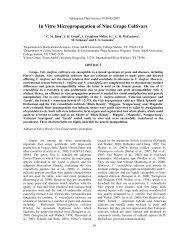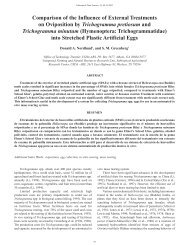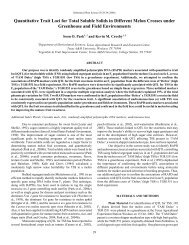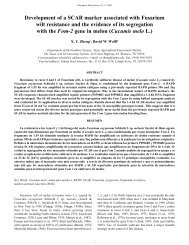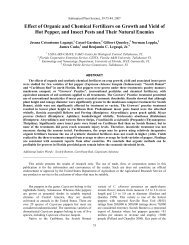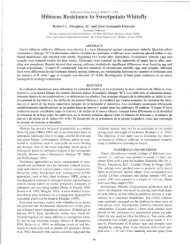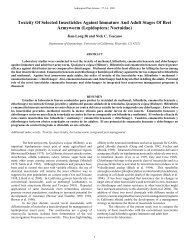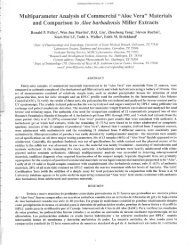Mexican Fruit Fly, Anastrepha ludens - Subtropical Plant Science ...
Mexican Fruit Fly, Anastrepha ludens - Subtropical Plant Science ...
Mexican Fruit Fly, Anastrepha ludens - Subtropical Plant Science ...
Create successful ePaper yourself
Turn your PDF publications into a flip-book with our unique Google optimized e-Paper software.
<strong>Subtropical</strong> <strong>Plant</strong> <strong>Science</strong>, 52: 52-59.2000<br />
<strong>Mexican</strong> <strong>Fruit</strong> <strong>Fly</strong>, <strong>Anastrepha</strong> <strong>ludens</strong> (Loew)(Diptera:<br />
Tephritidae), Addendum to the Bibliography 1986-1999<br />
Donald B. Thomas<br />
Kika de la Garza <strong>Subtropical</strong> Agriculture Research Center, Crop Quality and <strong>Fruit</strong> Insects Research Unit,<br />
2301 S. International Blvd, Weslaco, TX 78596<br />
ABSTRACT<br />
The <strong>Mexican</strong> fruit fly is a major pest of tropical fruits including citrus and mangoes. Consequently it is a subject of<br />
active research with an extensive but scattered literature. The most recent bibliography, published in 1986, contained 205<br />
citations. An update to this bibliography, covering the period 1986 to 1999, includes an additional 171 citations.<br />
RESUMEN<br />
La mosca mexicana de la fruta es una de las plagas más importantes de frutos tropicales dentro de los que se<br />
incluyen los cítricos y los mangos. Debido a esto, esta plaga se esta estudiando constantemente con la consecuente<br />
producción de una vasta pero dispersa literatura. La bibliografía más reciente, publicada en 1986, incluyó 205 citas. Una<br />
actualización de esta bibliografía, que cubre el período 1986-1999, incluye 171 citas adicionales.<br />
Additional index words: citrus, quarantine, eradication, Rio Grande Valley.<br />
The <strong>Mexican</strong> fruit fly, <strong>Anastrepha</strong> <strong>ludens</strong> (Loew), is a<br />
major quarantine pest which has been a recurrent problem for<br />
growers of citrus in the Rio Grande Valley of Texas. It is the<br />
target of an intensive suppression program in Texas and<br />
California, and an eradication campaign in the fruit producing<br />
regions of Mexico. Both countries support active research<br />
programs seeking new or enhanced technologies for the control<br />
of this pest, the development of disinfestation protocols, and<br />
knowledge of its’ basic biology. These efforts have been aided<br />
by a <strong>Mexican</strong> fruit fly bibliography compiled by Holler &<br />
Calkins (1986) which included 205 citations covering nearly a<br />
century of published articles beginning with the first report of<br />
the “Morelos Orange fruit worm” as an economic pest by<br />
Howard (1888), to the proposed control of the Mexfly with the<br />
sterile insect technique by Holler et al. (1984).<br />
The present addendum to the bibliography covers the 14<br />
year period from 1986 through the end of the millenium,<br />
December 1999, and contains over 170 additional references.<br />
The increase in the rate of publication is testament to the<br />
importance of this quarantine pest to North American<br />
agriculture in the modern era. The bulk of this published<br />
research has emanated from three laboratories. Martin Aluja<br />
and associates based at the Instituto de Ecologia in Xalapa,<br />
Veracruz have actively pursued investigations in the areas of<br />
comparative ecology, host plant relationships, behavior, and<br />
natural enemies of the various pest species of <strong>Anastrepha</strong><br />
including A. <strong>ludens</strong>. In support of the <strong>Mexican</strong> national<br />
campaign against fruit flies entomologists attached to the<br />
sterile fruit fly production program in Tapachula, Chiapas have<br />
concentrated their efforts on improving diet, rearing methods,<br />
and the demographics of mass production.<br />
The bulk of the research published in the last 14 years,<br />
however, nearly half of the total citations, was produced by the<br />
USDA-ARS <strong>Fruit</strong> Insect and Crop Quality research unit<br />
located in Weslaco, Texas. Here the emphasis has been on the<br />
development of attractants, quarantine treatments, novel<br />
chemical controls, and technologies in support of the Texas<br />
eradication program.<br />
Consumer demand for tropical fruit has provided the<br />
impetus for much of this research. Concerns about health and<br />
the environment have brought pressure for reduction in the use<br />
of pesticides. Novel chemicals from natural (bacterial) sources<br />
or photoactive dyes with very low persistence in nature, and<br />
novel delivery systems such as bait stations, show promise as<br />
alternatives to broadcast insecticides (Mangan & Moreno<br />
1995). Non-chemical treatments such as heat, radiation, and<br />
controlled atmospheres have proven to be at least as<br />
efficacious as methyl bromide for disinfesting fruit postharvest<br />
(Shellie et al. 1997, Mangan & Hallman 1998, Hallman<br />
1999). Yet, many problems remain to be solved. As pest<br />
management programs shift from control to eradication and the<br />
maintenance of fly-free zones the lack of an efficient trap has<br />
emerged as a glaring weakness. Lures much superior to the<br />
traditional torula yeast slurry are available (Robacker &<br />
Warfield 1993) but have not yet been tested in survey and<br />
detection programs beyond an experimental basis. Substantial<br />
changes in our approach to the <strong>Mexican</strong> fruit fly problem are<br />
clearly in the offing for the new millenium.<br />
52
<strong>Subtropical</strong> <strong>Plant</strong> <strong>Science</strong>, 52: 52-59.2000<br />
The format for citation follows that used by Holler &<br />
Calkins (1986) who followed that used by the Bulletin of the<br />
Entomological Society of America. I have sought to include all<br />
articles published in scientific journals but not those in<br />
newspapers, magazines or lay periodicals. Book chapters are<br />
included if the subject matter deals primarily with the Mexfly<br />
or species of <strong>Anastrepha</strong> including A. <strong>ludens</strong>. Otherwise, no<br />
effort was made to include all incidental references to the<br />
Mexfly. Likewise, abstracts, theses and unpublished technical<br />
reports are not included.<br />
ACKNOWLEDGEMENTS<br />
Thanks are due C.O. Calkins, USDA-ARS, Wapato, WA,<br />
I. Fraser, and G.J. Hallman, USDA-ARS, Weslaco, TX, and<br />
A.J. Martinez, USDA-APHIS, Mission, TX, for reviews of the<br />
manuscript.<br />
1. Aluja, M.R. 1993. The study of movement in tephritid<br />
flies: review of concepts and recent advances. Pp. 105-<br />
113, in M. Aluja & P. Liedo [eds]. <strong>Fruit</strong> Flies: Biology and<br />
Management. Springer-Verlag, New York, NY.<br />
2. Aluja, M.R. 1993. Manejo Integral de las Moscas de la<br />
Fruta. Editorial Trillas, Mexico, DF.<br />
3. Aluja, M.R. 1994. Bionomics and management of<br />
<strong>Anastrepha</strong>. Annu. Rev. Entomol. 39: 155-178.<br />
4. Aluja, M.R. 1995. Future trends in fruit fly management.<br />
Pp. 309-320, in B.A. McPheron and G.J. Steck [eds.].<br />
<strong>Fruit</strong> <strong>Fly</strong> Pests: a world assessment of their biology and<br />
management. St. Lucie Press, Delray Beach, FL.<br />
5. Aluja, M.R., M. Cabrera, J. Guillen-Aguilar, H.<br />
Celedonio-Hurtado, & F. Ayora. 1989. Behavior of<br />
<strong>Anastrepha</strong> <strong>ludens</strong>, A. obliqua and A. serpentina (Diptera:<br />
Tephritidae) on a wild mango tree (Mangifera indica)<br />
harboring three McPhail traps. Insect. Sci. & Applic. 10:<br />
309-318.<br />
6. Aluja, M.R., H. Celedonio-Hurtado, P.F. Liedo, M.<br />
Cabrera, F. Castillo, J. Guillen-Aguilar & E. Rios. 1996.<br />
Seasonal population fluctuations and ecological<br />
implications for management of <strong>Anastrepha</strong> fruit flies<br />
(Diptera: Tephritidae) in commercial mango orchards in<br />
southern Mexico. J. Econ. Entomol. 89: 654-667.<br />
7. Aluja, M.R., H. Celedonio-Hurtado, P.F. Liedo & J.<br />
Guillen-Aguilar. 1986. Some results of general interest for<br />
control of <strong>Anastrepha</strong> spp. (Diptera: Tephritidae). pp. 209-<br />
216, in, Cavalloro, R. [ed.]. <strong>Fruit</strong> Flies of Economic<br />
Importance 84. Proc. CEC/IOBC Meeting, Hamburg, 1984.<br />
8. Aluja, M.R., J. Guillen-Aguilar, P.F. Liedo, M. Cabrera, E.<br />
Rios, G. De la Rosa, H. Celedonio-Hurtado & D. Mota.<br />
1990. <strong>Fruit</strong> infesting tephritids (Diptera: Tephritidae) and<br />
associated parasitoids in Chiapas, Mexico. Entomophaga<br />
35: 39-48.<br />
9. Aluja, M.R., J. Guillen-Aguilar, G. de la Rosa, M.<br />
Cabrera, H. Celedonio-Hurtado, P.F. Liedo & J.<br />
Hendrichs. 1987. Natural host plant survey of the<br />
economically important fruit flies (Diptera: Tephritidae) of<br />
Chiapas, Mexico. Fla. Entomol. 70: 329-338.<br />
10. Aluja, M.R. & P.F. Liedo. 1986. Perspectives on future<br />
integrated management of fruit flies in Mexico. Pp. 9-42<br />
in, M. Mangel, J. Carey & R. <strong>Plant</strong> [eds.]. Pest Control:<br />
Operations and Systems Analysis in <strong>Fruit</strong> <strong>Fly</strong><br />
Management. Springer-Verlag, New York, NY.<br />
11. Aluja, M.R., M. Lopez & J. Sivinski. 1998. Ecological<br />
evidence for diapause in four native and one exotic species<br />
of larval-pupal fruit fly (Diptera: Tephritidae) parasitoids<br />
in tropical environments. Ann. Entomol. Soc. Amer. 91:<br />
821-833.<br />
12. Aluja, M., J. Pinero, I. Jacome, F. Diaz-Fleischer & J.<br />
Sivinski. 2000. Behavior of flies in the genus <strong>Anastrepha</strong><br />
(Trypetinae: Toxotrypanini). Pp. 375-408, in: M. Aluja &<br />
A. Norrbom [eds.]. <strong>Fruit</strong> Flies (Tephritidae): phylogeny<br />
and evolution of behavior. CRC Press. Boca Raton, FL.<br />
13. Baker, J.D. & R.R. Heath. 1992. NMR spectral assignment<br />
of lactone pheromone components emitted by Caribbean<br />
and <strong>Mexican</strong> fruit flies. J. Chem. Ecol. 19: 1511-1519.<br />
14. Baker, P.S. & A.S. Chan. 1991. Appetitive dispersal of<br />
sterile fruit flies: aspects of the methodology and analysis<br />
of trapping studies. J. Appl. Entomol. 112: 263-273.<br />
15. Baker, P.S., A.S. Chan & M.A. Jimeno-Zavala. 1986.<br />
Dispersal and orientation of sterile Ceratitis capitata and<br />
<strong>Anastrepha</strong> <strong>ludens</strong> (Tephritidae) in Chiapas, Mexico. J.<br />
Appl. Ecol. 23: 27-38.<br />
16. Battiste, M.A., L. Strekowski, J.M. Coxon, R.L. Wydra &<br />
D.B.Harden. 1991. Highly stereoselective rearrangment of<br />
(E,E)-Suspensolide to Anastrephin and Epianastrephin.<br />
Tetrahedron Letters 32: 5303-5304.<br />
17. Berrigan, D.A., J.R. Carey, J. Guillen-Aguilar & H.<br />
Celedonio-Hurtado. 1988. Age and host effects on clutch<br />
size in the <strong>Mexican</strong> fruit fly, <strong>Anastrepha</strong> <strong>ludens</strong>. Entomol.<br />
Exp. & Applic. 47: 73-80.<br />
18. Bustos, M.E., J. Toledo, W.R. Enkerlin, H. Carrasco & J.<br />
Reyes. 1993. Irradiation as a quarantine treatment for<br />
<strong>Mexican</strong> mangoes. Pp. 341-344 in, M. Aluja & P. Liedo<br />
[eds.]. <strong>Fruit</strong> Flies: Biology and Management. Springer-<br />
Verlag, New York, NY.<br />
19. Carlson, D.A. & S.R. Yocom. 1986. Cuticular<br />
hydrocarbons from six species of tephritid fruit flies. Arch.<br />
Insect Biochem. & Physiol. 3: 397-412.<br />
20. Carroll, L.E. & R.A. Wharton. 1989. Morphology of the<br />
immature stages of <strong>Anastrepha</strong> <strong>ludens</strong> (Diptera:<br />
Tephritidae). Ann. Entomol. Soc. Amer. 82: 201-214.<br />
21. Cayol, J.P. 2000. Changes in sexual behavior and life<br />
history traits of Tephritid species caused by mass-rearing<br />
processes. Pp. 843-860, in: M.R. Aluja & A.L. Norrbom<br />
[eds.]. <strong>Fruit</strong> Flies (Tephritidae): phylogeny and evolution<br />
of behavior. CRC Press, Boca Raton, FL.<br />
22. Celedonio-Hurtado, H., M.R. Aluja & P.F. Liedo. 1995.<br />
Adult population fluctuations of <strong>Anastrepha</strong> species<br />
(Diptera: Tephritidae) in tropical orchard habitats of<br />
Chiapas, Mexico. Environ. Entomol. 24: 861-869.<br />
23. Celedonio-Hurtado, H., P.F. Liedo, M.R. Aluja, J. Guillen-<br />
Aguilar, D. Berrigan & J. Carey. 1988. Demography of<br />
<strong>Anastrepha</strong> <strong>ludens</strong>, A. obliqua, and A. serpentina (Diptera:<br />
Tephritidae) in Mexico. Fla. Entomol. 71: 111-119.<br />
24. Diaz-Fleischer, F., D.R. Papaj, R.J. Prokopy, A.L.<br />
Norrbom & M. Aluja. 2000. Evolution of fruit fly oviposition<br />
53
<strong>Subtropical</strong> <strong>Plant</strong> <strong>Science</strong>, 52: 52-59.2000<br />
behavior. Pp. 811-842, in: M. Aluja & A.L. Norrbom<br />
[eds.]. <strong>Fruit</strong> Flies (Tephritidae): phylogeny and evolution<br />
of behavior. CRC Press, Boca Raton, FL.<br />
25. Diaz-Fleischer, F., J. Toledo, W. Enkerlin & J. Hernandez.<br />
1996. Cyromazine: effects on three species of <strong>Anastrepha</strong>.<br />
Pp. 333-337 in: B.A. McPheron & G.J. Steck [eds.]. <strong>Fruit</strong><br />
<strong>Fly</strong> Pests: a world assessment of their biology and<br />
management. St. Lucie Press, Delray Beach, FL.<br />
26. Dickens, J.C., W.G. Hart, D.M. Light & E.B. Jang. 1988.<br />
Tephritid olfaction: morphology of the antennae of four<br />
tropical species of economic importance (Diptera:<br />
Tephritidae). Ann. Entomol. Soc. Am. 81: 325-331.<br />
27. Economopoulos, A.P. & G.E. Haniotakis. 1996. Advances<br />
in attractant and trapping technologies for Tephritids. Pp.<br />
57-66, In: C.O. Calkins, W. Klaussen & P. Liedo [eds.]:<br />
<strong>Fruit</strong> Flies and the Sterile Insect Technique. CRC Press,<br />
Boca Raton, FL.<br />
28. Enkerlin, W., L. Lopez & H. Celedonio-Hurtado. 1996.<br />
Increased accuracy in discrimination between captured<br />
wild unmarked and released dye-marked adults in fruit fly<br />
(Diptera: Tephritidae) sterile release programs. J. Econ.<br />
Entomol. 89: 946-949.<br />
29. Enkerlin, W., J. Reyes & R. Villalobos. 1993. Use of a<br />
mixture of boric acid, borax, hydrolysed protein, and water<br />
to control <strong>Anastrepha</strong> fruit flies. Pp. 353-358 in, M. Aluja<br />
& P. Liedo [eds.]. <strong>Fruit</strong> Flies: Biology and Management.<br />
Springer-Verlag, New York, NY.<br />
30. Enkerlin, W., J. Reyes, A. Bernabe, A. Sanchez, J. Toledo<br />
& M. Aluja. 1993. Estatus del aguacate “Hass” como<br />
hospedero de tres especies de moscas de la fruta del genero<br />
<strong>Anastrepha</strong> (Diptera: Tephritidae) en condiciones forzadas<br />
y naturales. Agrociencia 4: 329-348.<br />
31. Epsky, N.D., R.R. Heath, A. Guzman & W.L. Meyer.<br />
1995. Visual cue and chemical cue interactions in a dry<br />
trap with food-based synthetic attractant for Ceratitis<br />
capitata and <strong>Anastrepha</strong> <strong>ludens</strong> (Diptera: Tephritidae).<br />
Environ. Entomol. 24: 1387-1395.<br />
32. Eskafi, F.M. 1988. Infestation of Citrus by <strong>Anastrepha</strong><br />
spp. and Ceratitis capitata (Diptera: Tephritidae) in high<br />
coastal plains of Guatemala. Environ. Entomol. 17: 52-58.<br />
33. Eskafi, F.M. 1990. Parasitism of fruit flies Ceratitis<br />
capitata and <strong>Anastrepha</strong> spp. (Diptera: Tephritidae) in<br />
Guatemala. Entomophaga 35: 355-362.<br />
34. Eskafi, F.M. & R.T. Cunningham. 1987. Host plants of<br />
fruit flies (Diptera: Tephritidae) of economic importance<br />
in Guatemala. Fla. Entomol. 70: 116-123.<br />
35. Gabayet, J.A.R., J.R. Flores & W. Enkerlin-Hoeflich.<br />
1996. The <strong>Mexican</strong> national fruit fly eradication<br />
campaign: largest fruit fly industrial complex in the world.<br />
Pp. 561-563, in, B.A. McPheron & G.J. Steck [eds.]. <strong>Fruit</strong><br />
<strong>Fly</strong> Pests: a world assessment of their biology and<br />
management. St. Lucie Press, Delray Beach, FL.<br />
36. Gingrich, R.E. 1993. Biological control of tephritid fruit<br />
flies by inundative releases of natural enemies. Pp. 310-<br />
318, in, M. Aluja & P. Liedo [eds.]. <strong>Fruit</strong> Flies: Biology<br />
and Management. Springer-Verlag, New York, NY.<br />
37. Gutierrez-Samperio, J. Reyes & A. Villasenor. 1993.<br />
National plan against fruit flies in Mexico. Pp. 419-423,<br />
in, M. Aluja & P. Liedo [eds.]. <strong>Fruit</strong> Flies: Biology and<br />
Management. Springer-Verlag, New York, NY.<br />
38. Hallman, G.J. & M.J. Quinlan. 1996. Synopsis of<br />
postharvest quarantine treatment research. Pp. 473-477, in,<br />
B.A. McPheron & G.J. Steck [eds]. <strong>Fruit</strong> <strong>Fly</strong> Pests: a<br />
world assessment of their biology and management. St.<br />
Lucie Press, Delray Beach, FL.<br />
39. Hallman, G.J. 1997. Mortality of <strong>Mexican</strong> fruit fly<br />
(Diptera: Tephritidae) immatures in coated grapefruits.<br />
Fla. Entomol. 80: 324-328.<br />
40. Hallman, G.J. 1999. Lethality of cold to third instars,<br />
pupae, and pharate adults of the <strong>Mexican</strong> fruit fly (Diptera:<br />
Tephritidae). J. Econ. Entomol. 92: 480-484.<br />
41. Hallman, G.J. 1999. Ionizing radiation quarantine<br />
treatments against tephritid fruit flies. Postharv. Biol. &<br />
Technol. 16: 93-106.<br />
42. Hallman, G.J. & J.W. Worley. 1999. Gamma radiation<br />
doses to prevent adult emergence from immatures of<br />
<strong>Mexican</strong> and West Indian fruit flies (Diptera: Tephritidae).<br />
J. Econ. Entomol. 92: 967-973.<br />
43. Hallman, G.J. & Q.H. Zhang. 1997. Inhibition of fruit fly<br />
(Diptera: Tephritidae) development by pulsed electric<br />
field. Fla. Entomol. 80: 239-248.<br />
44. Heath, R.R., N.D. Epsky, S. Bloem, K. Bloem, F.<br />
Acajabon, A. Guzman & D. Chambers. 1994. pH effect on<br />
the attractiveness of a corn hydrosylate to the<br />
Mediterranean fruit fly and several <strong>Anastrepha</strong> species<br />
(Diptera: Tephritidae). J. Econ. Entomol. 87: 1008-1013.<br />
45. Heath, R.R., N.D. Epsky, B.D. Dueben, J. Rizzo & F.<br />
Jeronimo. 1997. Adding methyl-substituted ammonia<br />
derivatives to a food-based synthetic attractant on capture<br />
of Mediterranean and <strong>Mexican</strong> fruit flies (Diptera:<br />
Tephritidae). J. Econ. Entomol. 90: 1584-1589.<br />
46. Heath, R.R., N.D. Epsky, A. Guzman, B.D. Dueben, A.<br />
Manukian & W.L. Meyer. 1995. Development of a dry<br />
plastic insect trap with food-based synthetic attractant for<br />
the Mediterranean and <strong>Mexican</strong> fruit flies (Diptera:<br />
Tephritidae). J. Econ. Entomol. 88:1307-1315.<br />
47. Heath, R.R., P.J. Landolt, D.C. Robacker, B.D. Dueben &<br />
N.D. Epsky. 2000. Sexual pheromones of tephritid flies:<br />
clues to unravel phylogeny and behavior. Pp. 793-810, in:<br />
M. Aluja & A.L. Norrbom [eds.]. <strong>Fruit</strong> Flies (Tephritidae):<br />
phylogeny and evolution of behavior. CRC Press, Boca<br />
Raton, FL.<br />
48. Hernandez-Ortiz, V. 1990. Lista preliminar de especies<br />
<strong>Mexican</strong>as del genero <strong>Anastrepha</strong> (Diptera: Tephritidae)<br />
con descripcion de nuevas especies, registros y<br />
sinonimias. Folia Entomol. Mex. 80: 227-244.<br />
49. Hernandez-Ortiz, V. 1992. El Genero <strong>Anastrepha</strong> Schiner<br />
in Mexico (Diptera: Tephritidae): taxonomia, distribucion<br />
y sus plantas huespuedes. Soc. Entomol. Mex., Instituto<br />
Ecologia Publ. No. 33, Jalapa, Mexico.<br />
50. Hernandez-Ortiz, V. & M.R. Aluja. 1993. Listado de<br />
especies del genero neotropical <strong>Anastrepha</strong> (Diptera:<br />
Tephritidae) con notas sobre su distribucion y plantas<br />
hospederas. Folia Entomol. Mex. 88: 89-105.<br />
51. Hernandez-Ortiz, V. & R. Perez-Alonso. 1993. The natural<br />
host plants of <strong>Anastrepha</strong> (Diptera: Tephritidae) in a<br />
54
<strong>Subtropical</strong> <strong>Plant</strong> <strong>Science</strong>, 52: 52-59.2000<br />
tropical rain forest of Mexico. Fla. Entomol. 76: 447-460.<br />
52. Hernandez-Ortiz, V., R. Perez-Alonso, & R. Wharton.<br />
1994. Native parasitoids associated with the genus<br />
<strong>Anastrepha</strong> (Diptera: Tephritidae) in Los Tuxtlas,<br />
Veracruz, Mexico. Entomophaga 39: 171-178.<br />
53. Hodgson, P.J., J. Sivinski, G. Quintero & M. Aluja. 1998.<br />
Depth of pupation and survival of fruit fly (<strong>Anastrepha</strong><br />
spp: Tephritidae) pupae in a range of agricultural habitats.<br />
Environ. Entomol. 27: 1310-1314.<br />
54. Holler, T.C. & C.O. Calkins. 1986. <strong>Anastrepha</strong> <strong>ludens</strong><br />
(Loew) (Diptera: Tephritidae): a selected bibliography<br />
(1888-1986). J. Rio Grande Hort. Soc. 39: 41-53.<br />
55. Jiron, L.F., J. Soto & A.L. Norrbom. 1988. A preliminary<br />
list of the fruit flies of the genus <strong>Anastrepha</strong> (Diptera:<br />
Tephritidae) in Costa Rica. Fla. Entomol. 71: 130-137.<br />
56. Lee, C., A.B. DeMilo, D.S. Moreno & A.J. Martinez. 1995.<br />
Analysis of the volatile components of a bacterial<br />
fermentation that is attractive to the <strong>Mexican</strong> <strong>Fruit</strong> <strong>Fly</strong>,<br />
<strong>Anastrepha</strong> <strong>ludens</strong>. J. Agric. & Food Chem. 43: 1348-1351.<br />
57. Lee, C., A.B. DeMilo, D. S. Moreno & R.L. Mangan.<br />
1997. Identification of the volatile components of E802<br />
Mazoferm steepwater, a condensed fermented corn<br />
extractive highly attractive to the <strong>Mexican</strong> fruit fly<br />
(Diptera: Tephritidae). J. Agric. & Food Chem. 45:<br />
2327-2331.<br />
58. Lester, G.E. & D.A. Wolfenbarger. 1990. Comparisons of<br />
cobalt-60 gamma irradiation dose rates on grapefruit<br />
flavedo tissue and on <strong>Mexican</strong> fruit fly mortality. J. Food<br />
Protection 53: 329-331.<br />
59. Leyva-Vazquez, J.L. 1988. Temperatura umbral y<br />
unidades calor requeridas por los estados inmadurados de<br />
<strong>Anastrepha</strong> <strong>ludens</strong> (Loew) (Diptera: Tephritidae). Folia<br />
Entomol. Mex. 74: 189-196.<br />
60. Leyva-Vazquez, J.L., H.W. Browning & F.E. Gilstrap.<br />
1991. Development of <strong>Anastrepha</strong> <strong>ludens</strong> (Diptera:<br />
Tephritidae) in several host fruit. Environ. Entomol. 20:<br />
1160-1165.<br />
61. Leyva-Vazquez, J.L., H.W. Browning & F.E. Gilstrap.<br />
1991. Effect of host fruit species, size, and color on<br />
parasitization of <strong>Anastrepha</strong> <strong>ludens</strong> (Diptera: Tephritidae)<br />
by Dichasmimorpha longicaudata (Hymenoptera:<br />
Braconidae). Environ. Entomol. 20: 1469-1474.<br />
62. Lezama-Gutierrez, R., J. Molina-Ochoa, O.L. Contreras-<br />
Ochoa, M. Gonzalez-Ramirez, A. Trujillo-De la Luz, & O.<br />
Rebolledo-Dominguez. 1996. Susceptibilidad de larvas de<br />
<strong>Anastrepha</strong> <strong>ludens</strong> (Diptera: Tephritidae) a diversos<br />
nematodos entomopatogenos (Steinernematidae y<br />
Heterorhabditidae). Vedalia 3: 31-33.<br />
63. Liedo, P.F. & J.R. Carey. 1994. Mass rearing of<br />
<strong>Anastrepha</strong> (Diptera: Tephritidae) fruit flies: a<br />
demographic analysis. J. Econ. Entomol. 87: 176-180.<br />
64. Liedo, P.F. & J.R. Carey. 1996. Demography of fruit flies<br />
and implications to action programs. Pp. 299-308 in: B.A.<br />
McPheron & G.J. Steck [eds.]. <strong>Fruit</strong> <strong>Fly</strong> Pests: a world<br />
assessment of their biology and management. St. Lucie<br />
Press, Delray Beach, FL.<br />
65. Liedo, P.F., J.R. Carey, H. Celedonio-Hurtado & J.<br />
Guillen-Aguilar. 1993. Demography of <strong>Anastrepha</strong> fruit<br />
flies: a case study of three species of economic<br />
importance. Pp. 119-124 in, M. Aluja & P. Liedo [eds.].<br />
<strong>Fruit</strong> Flies: Biology and Management. Springer-Verlag,<br />
New York, NY.<br />
66. Liedo, P.F., J.R. Carey, H. Celedonio-Hurtado & J.<br />
Guillen-Aguilar. 1991. Size specific demography of three<br />
species of <strong>Anastrepha</strong> fruit flies. Entomol. Exp. & Appl.<br />
63: 135-142.<br />
67. Lopez, M., M. Aluja & J. Sivinski. 1999. Hymenopterous<br />
larval parasitoids of <strong>Anastrepha</strong> flies (Diptera:<br />
Tephritidae) in Mexico. Biol. Control 15: 119-129.<br />
68. Malacrida, A.R., C.R. Guglielmino, P. D’Adamo, C. Torti,<br />
F. Marinoni & G. Gasperi. 1995. Allozyme divergence and<br />
phylogenetic relationships among species of tephritid<br />
flies. Heredity 76: 592-602.<br />
69. Malo, E.A. 1992. Effect of bait decomposition time on<br />
capture of <strong>Anastrepha</strong> fruit flies. Fla. Entomol. 75: 272-274.<br />
70. Malo, E.A., P.S. Baker & J. Valenzuela. 1987. The<br />
abundance of species of <strong>Anastrepha</strong> (Diptera: Tephritidae)<br />
in the coffee producing area of coastal Chiapas, southern<br />
Mexico. Fol. Entomol. Mex. 73: 125-140.<br />
71. Malo, E.A. & G.I. Zapien. 1994. McPhail trap captures of<br />
<strong>Anastrepha</strong> obliqua and <strong>Anastrepha</strong> <strong>ludens</strong> (Diptera:<br />
Tephritidae) in relation to time of day. Fla. Entomol. 77:<br />
290-294.<br />
72. Mangan, R.L. 1996. Effects of adult chill treatments on<br />
mate attracting potential for irradiated <strong>Mexican</strong> fruit fly<br />
males. Entomol. Exp. & Appl. 79: 153-159.<br />
73. Mangan, R.L. 1997. Effects of strain and access to males<br />
on female longevity, lifetime oviposition rate, and egg<br />
fertility of the <strong>Mexican</strong> fruit fly (Diptera: Tephritidae). J.<br />
Econ. Entomol. 90: 945-954.<br />
74. Mangan, R.L., E.R. Frampton, D.B. Thomas & D.S.<br />
Moreno. 1997. Application of the maximum pest limit<br />
concept to quarantine security standards for the <strong>Mexican</strong><br />
fruit fly (Diptera: Tephritidae). J. Econ. Entomol. 90:<br />
1433-1440.<br />
75. Mangan, R.L. & G.J. Hallman. 1998. Temperature<br />
treatments for quarantine security: new approaches for<br />
fresh commodities. Pp. 201-234, in: G. Hallman & D.<br />
Denlinger [eds.]. Temperature Sensitivity in Insects.<br />
Westview, Boulder, CO.<br />
76. Mangan, R.L. & S.J. Ingle. 1994. Forced hot air treatment<br />
for grapefruit infested with <strong>Mexican</strong> fruit fly (Diptera:<br />
Tephritidae). J. Econ. Entomol. 87: 1574-1579.<br />
77. Mangan, R.L. & D.S. Moreno. 1995. Development of<br />
phloxine B and uranine bait for control of <strong>Mexican</strong> fruit<br />
fly. Pp. 116-126, in: J.R. Heitz & K.R. Downum [eds.].<br />
Light Activated Pest Control. Amer. Chem. Soc. Symp. 616.<br />
78. Mangan, R.L., D.S. Moreno & M. Sanchez-Riviello. 1992.<br />
Interaction of wild males and laboratory-adapted females<br />
of the <strong>Mexican</strong> fruit fly (Diptera: Tephritidae) in natural<br />
habitats. Environ. Entomol. 21: 294-300.<br />
79. Mangan, R.L., K.C. Shellie, S.J. Ingle & M.J. Firko. 1998.<br />
High temperature forced-air treatments with fixed time<br />
and temperature for ‘Dancy’ tangerines, ‘Valencia’<br />
oranges, and ‘Rio Star’ grapefruits. J. Econ. Entomol. 91:<br />
933-939.<br />
55
<strong>Subtropical</strong> <strong>Plant</strong> <strong>Science</strong>, 52: 52-59.2000<br />
80. Mangan, R.L. & J.L. Sharp. 1994. Combination and<br />
multiple treatments. Pp. 239-247, in, G. Hallman [ed.].<br />
Quarantine Treatments for Pests of Food <strong>Plant</strong>s. Westview<br />
Press, Boulder, CO.<br />
81. Martinez, A.J., T.C. Holler & J.N. Worley. 1987. A<br />
fructose and yeast hydrolysate diet for the irradiated<br />
<strong>Mexican</strong> fruit fly adult, <strong>Anastrepha</strong> <strong>ludens</strong> (Loew) and its<br />
effect on male longevity. Southw. Entomol. 12: 317-320.<br />
82. Martinez, A.J. & D.S. Moreno. 1991. Effect of<br />
cyromazine on the oviposition of <strong>Mexican</strong> fruit fly<br />
(Diptera: Tephritidae) in the laboratory. J. Econ. Entomol.<br />
84: 1540-1543.<br />
83. Martinez, A.J., D.C. Robacker, J.A. Garcia & K.L. Esau.<br />
1994. Laboratory and field olfactory attraction of the<br />
<strong>Mexican</strong> fruit fly (Diptera: Tephritidae) to metabolites of<br />
bacterial species. Fla. Entomol. 77: 117-126.<br />
84. Martinez, A.J., D.C. Robacker & J.A. Garcia. 1997.<br />
Toxicity of an isolate of Bacillus thuringiensis subspecies<br />
darmstadiensis to adults of the <strong>Mexican</strong> fruit fly<br />
(Diptera: Tephritidae) in the laboratory. J. Econ. Entomol.<br />
90: 130-134.<br />
85. Martinez, I. & V. Hernandez-Ortiz. 1997. Anatomy of the<br />
reproductive system in six <strong>Anastrepha</strong> species and<br />
comments regarding their terminology in Tephritidae<br />
(Diptera). Proc. Entomol. Soc. Wash. 99: 727-743.<br />
86. McPheron, B.A., H.-Y. Han, J.G. Silva & A.L. Norrbom.<br />
2000. Phylogeny of the genera <strong>Anastrepha</strong> and<br />
Toxotrypana (Trypetinae: Toxotrypanini) based on<br />
morphology. Pp. 299-342, in: M. Aluja & A.L. Norrbom<br />
[eds.]. <strong>Fruit</strong> Flies (Tephritidae): Phylogeny and Evolution<br />
of Behavior. CRC Press. Boca Raton Fl.<br />
87. Messing, R.H. & E.B. Jang. 1992. Response of the fruit fly<br />
parasitoid Diachasmimorpha longicaudata (Hymenoptera:<br />
Braconidae) to host-fruit stimuli. Environ. Entomol. 21:<br />
1189-1195.<br />
88. Montero, C.A.B. & J.A. Sanchez-Salas. 1990. Evaluation<br />
of six different traps for detecting the <strong>Mexican</strong> fruit fly.<br />
Southw. Entomol. 15: 327-331.<br />
89. Moreno, D.S. & R.L. Mangan. 1995. Responses of the<br />
<strong>Mexican</strong> fruit fly (Diptera: Tephritidae) to two hydrolyzed<br />
proteins and incorporation of Phloxine B to kill adults. Pp.<br />
258-279, in: J.R. Heitz & K.R. Downum [eds.]. Light<br />
Activated Pest Control. Am. Chem. Soc. Symp. 616.<br />
90. Moreno, D.S., A.J. Martinez & M. Sanchez-Riviello.<br />
1994. Cyromazine effects on the reproduction of<br />
<strong>Anastrepha</strong> <strong>ludens</strong> (Diptera: Tephritidae) in the laboratory<br />
and in the field. J. Econ. Entomol. 87: 202-211.<br />
91. Moreno, D.S., M. Sanchez-Riviello, D.C. Robacker & J.N.<br />
Worley. 1991. Mating competitiveness of irradiated<br />
<strong>Mexican</strong> fruit fly (Diptera: Tephritidae). J. Econ. Entomol.<br />
84: 1227-1234.<br />
92. Nilhake, S.S., J.N. Worley, R. Garcia, J.L. Davidson. 1991.<br />
<strong>Mexican</strong> fruit fly protocol helps export Texas citrus.<br />
Subtrop. <strong>Plant</strong> Sci. 44: 49-52.<br />
93. Norrbom, A. & R.H. Foote. 1989. The taxonomy and<br />
zoogeography of the genus <strong>Anastrepha</strong> (Diptera:<br />
Tephritidae). Pp. 15-26, in: A.S. Robinson & G. Hooper<br />
[eds.], <strong>Fruit</strong> Flies, their Biology, Natural Enemies and<br />
Control. Elesevier, Amsterdam.<br />
94. Norrbom, A. & K.C. Kim. 1988. A list of the reported host<br />
plants of the species of <strong>Anastrepha</strong> (Diptera: Tephritidae).<br />
USDA-APHIS, 81-52.<br />
95. Norrbom, A., R.A. Zucchi & V. Hernandez-Ortiz. 2000.<br />
Phylogeny of the genera <strong>Anastrepha</strong> and Toxotrypana<br />
(Trypetinae: Toxotrypanini) based on morphology. Pp.<br />
299-342, in: M. Aluja & A.L. Norrbom [eds.]. <strong>Fruit</strong> Flies<br />
(Tephritidae): phylogeny and evolution of behavior. CRC<br />
Press, Boca Raton, FL.<br />
96. O’Doherty, R. & J.E. Link. 1993. <strong>Fruit</strong> flies in Belize,<br />
Central America. Pp. 35-37 in, M. Aluja & P. Liedo [eds.].<br />
<strong>Fruit</strong> Flies: Biology and Management. Springer-Verlag,<br />
New York, NY.<br />
97. Papaj, D.R. & M. Aluja. 1993. Temporal dynamics of hostmarking<br />
in the tropical tephritid fly, <strong>Anastrepha</strong> <strong>ludens</strong>.<br />
Physiol. Entomol. 18: 279-284.<br />
98. Pinson, E., W. Enkerlin, S. Arrazate & A. Oropeza. 1993.<br />
Adaptation of <strong>Anastrepha</strong> <strong>ludens</strong> (Loew) to an enriched<br />
recycled diet. Pp. 285-287 in: M. Aluja & P. Liedo [eds.].<br />
<strong>Fruit</strong> Flies: Biology and Management. Springer-Verlag,<br />
New York, NY.<br />
99. Riherd, C., R. Nguyen & J.R. Brazzel. 1994. Pest free<br />
areas. Pp. 213-223, in: J.L. Sharp & G.J. Hallman [eds.].<br />
Quarantine Treatments for Pests of Food <strong>Plant</strong>s. Westview<br />
Press, Boulder, CO.<br />
100. Robacker, D.C. 1988. Behavioral responses of female<br />
<strong>Mexican</strong> <strong>Fruit</strong> Flies, <strong>Anastrepha</strong> <strong>ludens</strong>, to components of<br />
male-produced sex pheromone. J. Chem. Ecol. 14: 1715-<br />
1726.<br />
101. Robacker, D.C. 1991. Specific hunger in <strong>Anastrepha</strong><br />
<strong>ludens</strong> (Diptera: Tephritidae): effects on attractiveness of<br />
proteinaceous and fruit-derived lures. Environ. Entomol.<br />
20: 1680-1686.<br />
102. Robacker, D.C. 1992. Effects of shape and size of colored<br />
traps on attractiveness to irradiated, laboratory-strain<br />
<strong>Mexican</strong> fruit flies (Diptera: Tephritidae). Fla. Entomol.<br />
75: 230-241.<br />
103. Robacker, D.C. 1993. Understanding olfactory attraction<br />
in <strong>Anastrepha</strong> using A. <strong>ludens</strong> as a model system. Pp. 201-<br />
206 in: M. Aluja & P. Liedo [eds.]. <strong>Fruit</strong> Flies: Biology and<br />
Management. Springer-Verlag, New York, NY.<br />
104. Robacker, D.C. 1995. Attractiveness of a mixture of<br />
ammonia, methylamine and putrescine to <strong>Mexican</strong> fruit<br />
flies (Diptera: Tephritidae) in a citrus orchard. Fla.<br />
Entomol. 78: 571-577.<br />
105. Robacker, D.C. 1998. Analysis of volatile amines from<br />
bacterial cultures and man-made matrices. Rec. Res.<br />
Devel. Agric. & Food Chem. 2: 125-140.<br />
106. Robacker, D.C. 1998. Effects of food deprivation, age,<br />
time of day, and gamma irradiation on attraction of<br />
<strong>Mexican</strong> fruit flies (Diptera: Tephritidae) to two synthetic<br />
lures in a wind tunnel. Environ. Entomol. 27: 1303-1309.<br />
107. Robacker, D.C. 1999. Attraction of wild and laboratorystrain<br />
of <strong>Mexican</strong> fruit flies (Diptera: Tephritidae) to two<br />
synthetic lures in a wind tunnel. Fla. Entomol. 82: 87-96.<br />
108. Robacker, D.C. 1999. Semiochemical systems of the<br />
<strong>Mexican</strong> fruit fly: how they work and interact. Recent Res.<br />
56
<strong>Subtropical</strong> <strong>Plant</strong> <strong>Science</strong>, 52: 52-59.2000<br />
Develop. Entomol. 2: 127-149.<br />
109. Robacker, D.C. & R.J. Bartelt. 1996. Solid-phase<br />
microextraction analysis of static-air emissions of<br />
ammonia, methylamine, and putrescine from a lure for the<br />
<strong>Mexican</strong> fruit fly (<strong>Anastrepha</strong> <strong>ludens</strong>). J. Agric. & Food<br />
Chem. 44: 3554-3559.<br />
110. Robacker, D.C. & R.J. Bartelt. 1997. Chemicals attractive<br />
to <strong>Mexican</strong> fruit fly from Klebsiella pneumoniae and<br />
Citrobacter freundii cultures sampled by solid-phase<br />
microextraction. J. Chem. Ecol. 23: 2897-2915.<br />
111. Robacker, D.C., B.C. Chapa & W.G. Hart. 1986.<br />
Electroantenagramms of <strong>Mexican</strong> fruit flies to chemicals<br />
produced by males. Entomol. Exp. Appl. 40: 123-127.<br />
112. Robacker, D.C., A.B. DeMilo & D.J. Voaden. 1997.<br />
<strong>Mexican</strong> fruit fly attractants: effects of 1-pyrroline and<br />
other amines on attractiveness of a mixture of ammonia,<br />
methylamine, and putrescine. J. Chem. Ecol. 23: 1263-1280.<br />
113. Robacker, D.C. & R.A. Flath. 1995. Attractants from<br />
Staphylococcus aureus cultures for <strong>Mexican</strong> <strong>Fruit</strong> <strong>Fly</strong>. J.<br />
Chem. Ecol. 21: 1861-1874.<br />
114. Robacker, D.C. & J.A. Garcia. 1990. Responses of<br />
laboratory-strain <strong>Mexican</strong> fruit flies, <strong>Anastrepha</strong> <strong>ludens</strong>, to<br />
combinations of fermenting fruit odor and male-produced<br />
pheromone in laboratory bioassays. J. Chem. Ecol. 16:<br />
2027-2038.<br />
115. Robacker, D.C. & J.A. Garcia. 1993. Effects of age, time<br />
of day, feeding history, and gamma irradiation on<br />
attraction of <strong>Mexican</strong> fruit flies (Diptera: Tephritidae), to<br />
bacterial odor in laboratory experiments. Environ.<br />
Entomol. 22: 1367-1374.<br />
116. Robacker, D.C., J.A. Garcia & W.G. Hart. 1990. Attraction<br />
of a laboratory strain of <strong>Anastrepha</strong> <strong>ludens</strong> (Diptera:<br />
Tephritidae) to the odor of fermented chapote fruit and to<br />
pheromones in laboratory experiments. Environ. Entomol.<br />
19: 403-408.<br />
117. Robacker, D.C., J.A. Garcia, A.J. Martinez & M.G.<br />
Kaufman. 1991. Strain of Staphylococcus attractive to<br />
laboratory strain <strong>Anastrepha</strong> <strong>ludens</strong>, from fermented host<br />
fruit. J. Chem. Ecol. 16: 2799-2815.<br />
118. Robacker, D.C. & W.G. Hart. 1986. Behavioral responses<br />
of male and female <strong>Mexican</strong> fruit flies, <strong>Anastrepha</strong> <strong>ludens</strong>,<br />
to male-produced chemicals in laboratory experiments. J.<br />
Chem. Ecol. 12: 39-47.<br />
119. Robacker, D.C. & R.R. Heath. 1996. Attraction of<br />
<strong>Mexican</strong> <strong>Fruit</strong> Flies (Diptera: Tephritidae) to lures<br />
emitting host-fruit volatiles in a citrus orchard. Fla.<br />
Entomol. 79: 600-602.<br />
120. Robacker, D.C. & R.R. Heath, 1997. Decreased attraction<br />
of <strong>Anastrepha</strong> <strong>ludens</strong> to combinations of two types of<br />
synthetic lures in a citrus orchard. J. Chem. Ecol. 23:<br />
1253-1262.<br />
121. Robacker, D.C., R.L. Mangan, D.S. Moreno & A. Tarshis-<br />
Moreno. 1991. Mating behavior and male mating success<br />
in wild <strong>Anastrepha</strong> <strong>ludens</strong> (Diptera: Tephritidae) on a<br />
field-caged host tree. J. Insect Behavior 4: 471-487.<br />
122. Robacker, D.C., A.J. Martinez, J.A. Garcia & R.J. Bartelt.<br />
1998. Volatiles attractive to the <strong>Mexican</strong> fruit fly (Diptera:<br />
Tephritidae) from eleven bacterial taxa. Fla. Entomol. 81:<br />
489-496.<br />
123. Robacker, D.C., A.J. Martinez, J.A. Garcia, M. Diaz & C.<br />
Romero. 1996. Toxicity of Bacillus thuringiensis to<br />
<strong>Mexican</strong> <strong>Fruit</strong> <strong>Fly</strong> (Diptera: Tephritidae). J. Econ.<br />
Entomol. 89: 104-110.<br />
124. Robacker, D.C. & D.S. Moreno. 1988. Responses of<br />
female <strong>Mexican</strong> fruit flies at various distances from maleproduced<br />
pheromone. Southw. Entomol. 13: 95-100.<br />
125. Robacker, D.C. & D.S. Moreno. 1995. Protein feeding<br />
attenuates attraction of <strong>Mexican</strong> <strong>Fruit</strong> Flies (Diptera:<br />
Tephritidae) to volatile bacterial metabolites. Fla.<br />
Entomol. 78: 39-44.<br />
126. Robacker, D.C., D.S. Moreno & A.B. DeMilo. 1996.<br />
Attractiveness to <strong>Mexican</strong> fruit flies of combinations of<br />
acetic acid with ammonium-amino attractants with<br />
emphasis on effects of hunger. J. Chem. Ecol. 22: 499-511.<br />
127. Robacker, D.C., D.S. Moreno & D.A. Wolfenbarger. 1990.<br />
Effects of trap color, height, and placement around trees<br />
on capture of <strong>Mexican</strong> <strong>Fruit</strong> Flies (Diptera: Tephritidae). J.<br />
Econ. Entomol. 83: 412-419.<br />
128. Robacker, D.C., A.M. Tarshis-Moreno, J.A. Garcia, and<br />
R.A. Flath. 1990. A novel attractant for <strong>Mexican</strong> <strong>Fruit</strong> <strong>Fly</strong>,<br />
<strong>Anastrepha</strong> <strong>ludens</strong>, from fermented host fruit. J. Chem.<br />
Ecol. 16: 2799-2815.<br />
129. Robacker, D.C. & W.C. Warfield. 1993. Attraction of both<br />
sexes of <strong>Mexican</strong> fruit fly, <strong>Anastrepha</strong> <strong>ludens</strong>, to a mixture<br />
of ammonia, methlyamine, and putrescine. J. Chem. Ecol.<br />
19: 2999-3016.<br />
130. Robacker, D.C., W.C. Warfield & R.A. Flath. 1992. A<br />
four-component attractant for the <strong>Mexican</strong> <strong>Fruit</strong> <strong>Fly</strong>,<br />
<strong>Anastrepha</strong> <strong>ludens</strong> (Diptera: Tephritidae), from host fruit.<br />
J. Chem. Ecol. 18: 1239-1254.<br />
131. Robacker, D.C., W.C. Warfield, & R.F. Albach. 1993.<br />
Partial characterization and HPLC isolation of bacteriaproduced<br />
attractants for the <strong>Mexican</strong> <strong>Fruit</strong> <strong>Fly</strong>, <strong>Anastrepha</strong><br />
<strong>ludens</strong>. J. Chem. Ecol. 19: 543-557.<br />
132. Robacker, D.C. & D.A. Wolfenbarger. 1988. Attraction<br />
of laboratory-reared, irradiated <strong>Mexican</strong> fruit flies to<br />
male-produced pheromone in the field. Southw. Entomol.<br />
13: 75-80.<br />
133. Rocca, J.R., J.L. Nation, L. Strekowski & M.A. Battiste.<br />
1992. Comparison of volatiles emitted by male Caribbean<br />
and <strong>Mexican</strong> fruit flies. J. Chem. Ecol. 18: 223-244.<br />
134. Rull-Gabayet, J.A., J. Reyes-Flores & W. Enkerlin-Hoeflich.<br />
1996. The <strong>Mexican</strong> national fruit fly eradication<br />
campaign: largest fruit fly industrial complex in the world.<br />
Pp. 561-563, in: B.A. McPheron & G.J. Steck [eds.]. <strong>Fruit</strong><br />
<strong>Fly</strong> Pests: a world assessment of their biology and<br />
management. St. Lucie Press, Delray Beach, FL.<br />
135. Servin-Villegas, R. & M.L. Jimenez-Jimenez. 1995. El<br />
Aparato reproductor y ciclo gonadico de la Mosca de la<br />
Fruta, <strong>Anastrepha</strong> <strong>ludens</strong>. Southw. Entomol. 20: 223-227.<br />
136. Sharp, J.L. 1988. Status of hot water immersion quarantine<br />
treatment for tephritidae immatures in mangos. Proc. Fla.<br />
State Hortic. Soc. 101: 195-197.<br />
137. Sharp, J.L. 1993. Quarantine treatments for major mango<br />
pests. Acta Hortic. 341: 407-414.<br />
138. Sharp, J.L., M.T. Ouye, S.J. Ingles & W.G. Hart. 1989. Hot<br />
57
<strong>Subtropical</strong> <strong>Plant</strong> <strong>Science</strong>, 52: 52-59.2000<br />
water quarantine treatment for Mangoes from Mexico<br />
infested with <strong>Mexican</strong> <strong>Fruit</strong> fly and West Indian fruit fly<br />
(Diptera: Tephritidae). J. Econ. Entomol. 82: 1657-1662.<br />
139. Shellie, K.C. 1994. Quality of “Manila” mango after heat<br />
treatments for fruit fly disinfestation. HortSci. 29: 483.<br />
140. Shellie, K.C., M.J. Firko & R.L. Mangan. 1993.<br />
Phytotoxic response of Dancy tangerine to hightemperature,<br />
moist, forced-air treatment for fruit fly<br />
disinfestation. J. Am. Soc. Hort. Sci. 118: 481-485.<br />
141. Shellie, K.C. & R.L. Mangan. 1994a. Postharvest quality<br />
of “Valencia” orange after exposure to hot, moist, forced<br />
air for <strong>Fruit</strong> <strong>Fly</strong> disinfestation. HortSci. 29: 1524-1527.<br />
142. Shellie, K.C. & R.L. Mangan. 1994b. Disinfestation:<br />
effect of non-chemical treatments on market quality of<br />
fruit. pp. 304-310, in: Champ, B.R. [ed.]. Postharvest<br />
Handling of Tropical <strong>Fruit</strong>s. ACIAR Proceedings.<br />
143. Shellie, K.C. & R.L. Mangan. 1995. Heating rate and<br />
tolerance of naturally degreened “Dancy” tangerine to<br />
high-temperature forced air for fruit fly disinfestation.<br />
HortTechnol. 5: 40-43.<br />
144. Shellie, K.C. & R.L. Mangan. 1996. Tolerance of redfleshed<br />
grapefruit to a constant or stepped temperature,<br />
forced-air quarantine heat treatment. Postharv. Biol. &<br />
Technol. 7: 151-159.<br />
145. Shellie, K.C., R.L. Mangan & S.J. Ingle. 1997. Tolerance<br />
of grapefruit and <strong>Mexican</strong> fruit fly larvae to heated<br />
controlled atmospheres. Postharv. Biol. & Technol. 10:<br />
179-186.<br />
146. Sivinski, J.M. 1996. The past and potential of biological<br />
control of fruit flies. Pp. 369-375, in, B. McPheron & G.<br />
Steck [eds.]. <strong>Fruit</strong> <strong>Fly</strong> Pests: a world assessment of their<br />
biology and management. St. Lucie Press, Delray Beach, FL.<br />
147. Sivinski, J.M., M. Aluja, G. Dodson, A. Freidberg, D.H.<br />
Headrick, K.Y. Kaneshiro & P.J. Landolt. 2000. Topics in<br />
the evolution of sexual behavior in the Tephritidae. Pp.<br />
751-792, in: M. Aluja & A.L. Norrbom [eds.]. <strong>Fruit</strong> Flies<br />
(Tephritidae): phylogeny and evolution of behavior. CRC<br />
Press, Boca Raton, FL.<br />
148. Sivinski, J.M., M. Aluja & M. Lopez. 1997. Spatial and<br />
temporal distributions of parasitoids of <strong>Mexican</strong><br />
<strong>Anastrepha</strong> species (Diptera: Tephritidae) within the<br />
canopies of fruit trees. Ann. Entomol. Soc. Am. 90: 604-618.<br />
149. Sivinski, J.M., K. Vulinec, E. Menezes & M. Aluja. 1998.<br />
The bionomics of Coptera haywardi (Oglobin)<br />
(Hymenoptera:Diapriidae) and other pupal parasitoids of<br />
tephritid fruit flies (Diptera). Biol. Contr. 11: 193-202.<br />
150. Steck, G.J., L.E. Carroll, H. Celedonio-Hurtado & J.<br />
Guillen-Aguilar. 1990. Methods for identification of<br />
<strong>Anastrepha</strong> larvae (Diptera: Tephritidae), and key to 13<br />
species. Proc. Entomol. Soc. Wash. 92: 333-346.<br />
151. Stevens, L.J. 1991. Manual of standard operating<br />
procedure (SOP) for the mass-rearing and sterilization of<br />
the <strong>Mexican</strong> <strong>Fruit</strong> <strong>Fly</strong>, <strong>Anastrepha</strong> <strong>ludens</strong> (Loew). USDA-<br />
APHIS PPQ Report, Feb. 1991.<br />
152. Stokes, J.B., E.C. Uebel, J.D. Warthen, M. Jacoson, J.L.<br />
Flippen-Anderson, R. Gilardi, L.M. Spishakoff & K.R.<br />
Wilzer. 1983. Isolation and identification of novel lactones<br />
from male <strong>Mexican</strong> <strong>Fruit</strong> Flies. J. Agric. Food Chem. 31:<br />
1162-1167.<br />
153. Tadano, K.I., Y. Isshiki, M. Minami & S. Ogawa. 1992.<br />
Samarium-II iodide mediated reductive cyclization<br />
approach to total synthesis of the insect sex attractant Levo<br />
Anastrephin. Tetrahedron Lett. 33: 7899-7902.<br />
154. Tadano, K.I., Y. Isshiki, M. Minami & S. Ogawa. 1993.<br />
Total syntheses of (-)-Anastrephin, (-)-Epianastrephin, and<br />
their 7a-Epimers: Use of Samarium (II) iodide-mediated<br />
intramolecular reductive coupling for the construction of<br />
their hexahydrobenzofuran-2(3H)-one skeleons. J. Org.<br />
Chem. 58: 6266-6279.<br />
155. Thomas, D.B. 1993. Survivorship of the pupal stages of<br />
the <strong>Mexican</strong> <strong>Fruit</strong> <strong>Fly</strong> <strong>Anastrepha</strong> <strong>ludens</strong> (Loew) (Diptera:<br />
Tephritidae) in an agricultural and non-agricultural<br />
situation. J. Entomol. Sci. 28: 350-362.<br />
156. Thomas, D.B. 1995. Predation on the soil inhabiting stages<br />
of the <strong>Mexican</strong> fruit fly. Southw. Entomol. 20: 61-71.<br />
157. Thomas, D.B. 1997. Degree-Day accumulations and<br />
seasonal duration of the pre-imaginal stages of the<br />
<strong>Mexican</strong> fruit fly (Diptera: Tephritidae). Fl. Entomol. 80:<br />
71-78.<br />
158. Thomas, D.B. 1998. Contribution of avian feces to<br />
fecundity in the <strong>Mexican</strong> fruit fly (Diptera: Tephritidae).<br />
Environ. Entomol. 27: 626-630.<br />
159. Thomas, D.B. & J. Loera-Gallardo. 1998. Dispersal and<br />
longevity of mass-released, sterilized <strong>Mexican</strong> fruit flies<br />
(Diptera: Tephritidae). Environ. Entomol. 27: 1045-1052.<br />
160. Thomas, D.B. & R.L. Mangan. 1995. Morbidity of the<br />
pupal stage of the <strong>Mexican</strong> and West Indian fruit flies<br />
(Diptera: Tephritidae) Induced by hot water immersion in<br />
the larval stage. Fla. Entomol. 78: 235-246.<br />
161. Thomas, D.B. & R.L. Mangan. 1997. Modeling thermal<br />
death in the <strong>Mexican</strong> fruit fly (Diptera: Tephritidae). J.<br />
Econ. Entomol. 90: 527-534.<br />
162. Thomas, D.B., J.N. Worley, R.L. Mangan, R.A. Vlasik &<br />
J.L. Davidson. 1999. <strong>Mexican</strong> fruit fly suppression with<br />
the sterile insect technique. Subtropic. <strong>Plant</strong> Sci. 51: 61-71.<br />
163. Toledo, J. 1993. Intensive gathering of potential fruit fly<br />
hosts to obtain biological material and as a cultural control<br />
method. Pp. 381-385 in: Aluja, M. & P. Liedo [eds.]. <strong>Fruit</strong><br />
Flies: Biology and Management. Springer-Verlag, New<br />
York, NY.<br />
164. Toledo, J., P. Liedo, T. Williams & J. Ibarra. 1999. Toxicity<br />
of Bacillus thuringiensis B-exotoxin to three species of<br />
fruit flies (Diptera: Tephritidae). J. Econ. Entomol. 92:<br />
1052-1056.<br />
165. Tomic-Carruthers, N., D.C. Robacker & R.L. Mangan.<br />
1996. Identification and age-dependence of Pteridines in<br />
the head of adult <strong>Mexican</strong> <strong>Fruit</strong> fly, <strong>Anastrepha</strong> <strong>ludens</strong>. J.<br />
Insect Physiol. 42: 359-366.<br />
166. Williamson, D.L. 1986. The <strong>Mexican</strong> fruit fly problem:<br />
alternatives for protecting fresh fruit commodities. J. Rio<br />
Grande Valley Hort. Soc. 39: 55-61.<br />
167. Williamson, D.L. & W.G. Hart. 1986. Progress in<br />
developing an internal color marker for <strong>Anastrepha</strong> <strong>ludens</strong><br />
Loew (Diptera: Tephritidae). 2nd Internat. Symp. <strong>Fruit</strong><br />
Flies/ Crete. Sept. 1986. Pp. 435-440.<br />
168.Williamson, D.L. & W.G. Hart. 1989. Current status of<br />
58
<strong>Subtropical</strong> <strong>Plant</strong> <strong>Science</strong>, 52: 52-59.2000<br />
<strong>Mexican</strong> fruit fly research in the Rio Grande Valley of<br />
Texas. Pp. 563-569, in R. Cavallaro [ed.] <strong>Fruit</strong> Flies of<br />
Economic Importance 87. Proc. CEC/IOBC Internat.<br />
Symp. April 1987. Balkema, Rotterdam.<br />
169. Williamson, D.L., K.R. Summy, W.G. Hart, M. Sanchez-<br />
Riviello, D.A. Wolfenbarger & B.D. Bruton. 1986.<br />
Efficacy and phytotoxicity of methyl bromide as a<br />
fumigant for the <strong>Mexican</strong> fruit fly (Diptera: Tephritidae) in<br />
grapefruit. J. Econ. Entomol. 79: 172-175.<br />
170. Wolfenbarger, D.A. & A.W. Guenthner. 1998. Effects of<br />
irradiation on <strong>Mexican</strong> fruit fly (Diptera: Tephritidae)<br />
larvae infesting grapefruit. Trop. Agric. (Trinidad) 75:<br />
375-379.<br />
171. Yamamura, K. & H. Katsumata. 1999. Estimation of the<br />
probability of insect pest introduction through imported<br />
commodities. Res. Popul. Ecol. 41: 275-282.<br />
59



